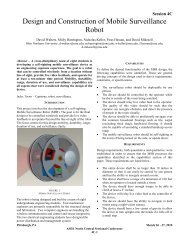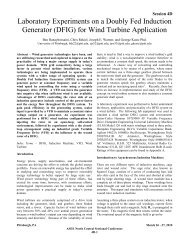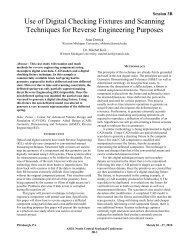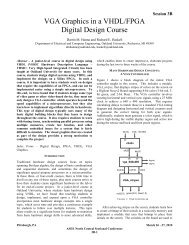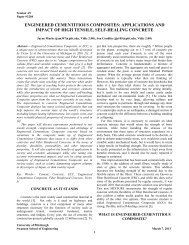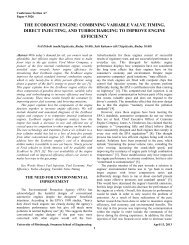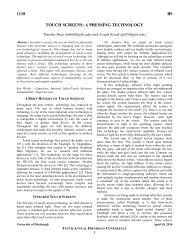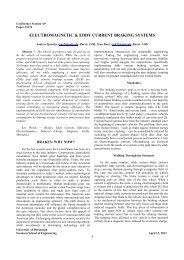You also want an ePaper? Increase the reach of your titles
YUMPU automatically turns print PDFs into web optimized ePapers that Google loves.
integrated into other systems and share data, therefore<br />
making devices more reliable, safer, and often more<br />
accurate.<br />
The next step in the complex line of control systems is<br />
the sampled-data system. Here, analog signals, sampled data,<br />
and pulse-modulated signals are put together and used<br />
simultaneously. An advantage to this is the sharing ability<br />
between equipment and signals [2].<br />
The most popular of these types is the digital system,<br />
which houses the ability to use analog signals, sampled data,<br />
and digital data. This code represents values in sequences,<br />
which help determine the actual value of digital information.<br />
Computers compare data and actually “think” about what the<br />
best adjustment is for the system. When more complicated<br />
control must be utilized, the digital direction is the obvious<br />
choice, as it can keep track of a lot of data and give<br />
calculated outputs based on logic switches [2]. A good<br />
example is automatic flight control in airplanes. The system<br />
must take into account a wide variety of data, such as lateral<br />
height, vertical height, and various forms of disturbances. To<br />
account for these, the main control system is a digital<br />
computer that acquires data from three independent systems<br />
monitoring these values. This proves the luxury that a digital<br />
system offers, as it can read many varieties of information at<br />
once and make smart choices based off of them [7].<br />
Control System Thought Process<br />
All control systems work on the same basic principle: they<br />
monitor output of a system and alter input to keep output<br />
consistent. Figure 2 illustrates the thought process behind<br />
how these systems go about analyzing information. An<br />
important factor is that this chart is a loop, which means the<br />
outputs and inputs are continuously monitored. In analog<br />
systems this is represented by mechanical or electrical<br />
signals and for digital systems a computer is preset to<br />
monitor this information at a given rate. The faster this<br />
monitoring process is performed, the more precise and<br />
accurate the output adjustments are for the system [8].<br />
FIGURE 2 [2]<br />
A necessary ability control systems must have is quick,<br />
logical reaction to unusual data. An engineer designs a<br />
system to be efficient and safe. Safety is important, and if a<br />
dangerous machine needs to be stopped, the control must<br />
react quickly and accurately. Consider a robot lawnmower<br />
once more. If the machine for some reason turns over, the<br />
Paper 1018<br />
blades would need to shut down, otherwise someone could<br />
get hurt. A control system in this scenario would need to be<br />
told to shut down all systems, otherwise the mower would be<br />
deemed unsafe for the public.<br />
SENSORS: ACQUIR<strong>IN</strong>G DATA<br />
The first step in a control system is to input data from the<br />
system. Sensors allow robots and control systems to see<br />
what is happening in the environment around them. A<br />
variety of sensors are available for different types of<br />
functions including movement, vision, balance and scientific<br />
data collection. What is relevant for control systems<br />
handling locomotion are sensors that deal with the first three<br />
functions of the list [9].<br />
Early robots used pegs at fixed points to stop movement.<br />
This proved inefficient over time as more technical and agile<br />
robots were made, and servo motors were implemented.<br />
Servo motors handle movement while also providing<br />
feedback. These motors read an encoder disk that has slits at<br />
defined points, as shown in Figure 3. Light sensors see when<br />
these points pass by and the time increment information<br />
gathered tells the motor how far it has turned. The robot is<br />
therefore able to detect the distance a leg or arm has moved,<br />
send this information to the control system, and make a<br />
decision to continue or stop motion [9][2]. Encoder disks are<br />
sometimes used alone as a means to find the angle of<br />
rotation in a system. In both applications, the more slits that<br />
are present in the disk, the more accurate the measurements<br />
are for the angles. An important note here is that in order for<br />
a robot to determine the change in angle, it must first know<br />
the number of slits present in the disk, otherwise calculations<br />
will be incorrect [10].<br />
FIGURE 3 [10]<br />
Potentiometers can also be used for sensing joint<br />
displacements. A potentiometer functions by comparing an<br />
output voltage to an input voltage. These devices incorporate<br />
a resistive track made out of carbon film, conductive<br />
ceramic, or wound wire. The distance through this track that<br />
the electricity must travel is changed by the physical location<br />
of a wiper that slides across the track. This change in<br />
distance causes a voltage change. Potentiometers are usually<br />
used as volume controls in stereos and can measure a change<br />
in angle caused by something rotating. Linear<br />
potentiometers also exist, which track a distance by moving<br />
University of Pittsburgh Swanson School of Engineering<br />
Eleventh Annual Freshman Conference April 9, 2011<br />
2




